
Key Takeways
- A digital asset management workflow is the structured process of creating, organizing, approving, distributing, and archiving digital assets. It helps teams manage content at scale with greater efficiency, consistency, and control.
- Without a clear workflow, even the best digital asset management tools can underperform. Disorganized assets, approval delays, and inconsistent branding are common symptoms of an unstructured process.
- Automation and integration are critical to scale. Features like auto-tagging, version control, and CMS or design tool integrations reduce manual work and accelerate production timelines.
- Platforms like BrandLife support every stage of the DAM workflow. From centralized asset storage to brand portals and built-in approvals, BrandLife helps teams stay aligned and campaign-ready.
If you manage content or creative assets at scale, a digital asset management (DAM) system is essential. These platforms offer centralized storage, version control, and smart tagging, making it easier for your team to find, use, and reuse assets efficiently.
With a solid system in place, you can build a structured digital asset management workflow that moves content seamlessly from creation to distribution while boosting collaboration, brand consistency, and ROI.
In this guide, we’ll break down the stages of a digital asset management workflow, explore key components, and share practical tips to help you build or improve your own workflow.
What Is the Digital Asset Management Workflow?
Unlike ad hoc content workflows or basic project workflows, digital asset management workflows are purpose-built to handle rich media and brand assets at scale. They ensure the right people have access to the right assets at the right time, while protecting brand integrity and reducing duplication.
Types of Digital Asset Management Workflows
There are two common models for digital asset management workflows: centralized and decentralized (or distributed).
Centralized workflows are more efficient and scalable when paired with a powerful digital asset management system like BrandLife.
These digital asset management platforms are designed to support centralized control with flexible permissions and access settings. It enables organizations to maintain brand consistency while still allowing for collaboration across teams and regions.
Why Brands Struggle Without a Digital Asset Management Workflow
Even the most advanced digital asset management solution can fall short without a structured workflow guiding how assets are managed. Without one, teams quickly run into issues like:
- Chaos and confusion: Marketing teams spend an average of 8.8 hours per week searching for digital assets . That’s over a full workday each week lost to searching alone.
- Brand risk: Inconsistent or outdated assets get used when approval processes aren’t clear.
- Collaboration breakdowns: Without defined handoff points and oversight, projects stall and communication falters.
A digital asset management system is only as strong as the workflow it supports. Building a clear, well-defined process ensures your digital asset management investment actually improves speed, consistency, and control across teams.
Key Components of a Digital Asset Management Workflow
A well-functioning digital asset management workflow is made up of several interconnected components, each playing a critical role in how assets are managed, shared, and scaled across teams.
Media library: central hub for assets
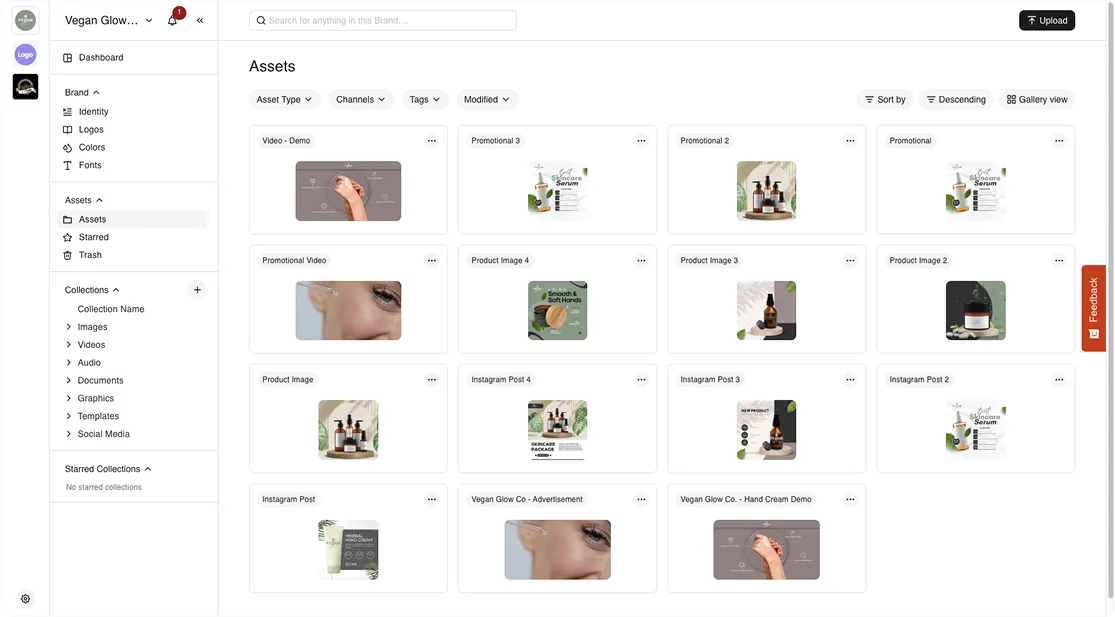
The media library is where all digital assets, including images, videos, documents, and any other digital files, live. It must be searchable, secure, and scalable.
Metadata and asset tagging
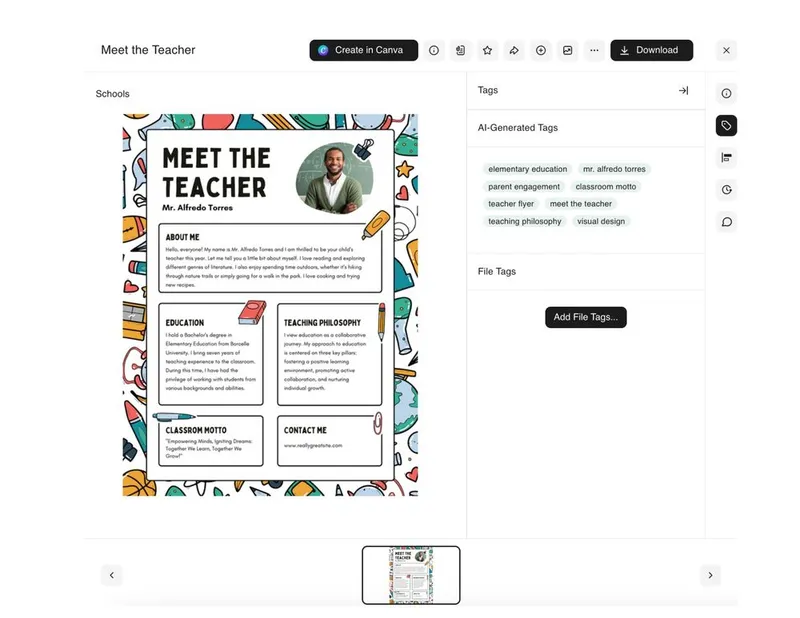
Metadata makes assets discoverable. Effective tagging structures support filtering by campaign, usage rights, product line, geography, and more. Platforms like BrandLife include automated, AI-assisted tagging to simplify this step and improve search accuracy.
Asset approval: feedback and version control

Review and approval stages are often bottlenecks. Digital asset management creative workflows with built-in approval tools streamline this phase, track feedback, and prevent outdated versions from being used.
BrandLife, for example, allows teams to comment, approve, and track changes—all within the platform.
Distribution: publishing, sharing, and using assets
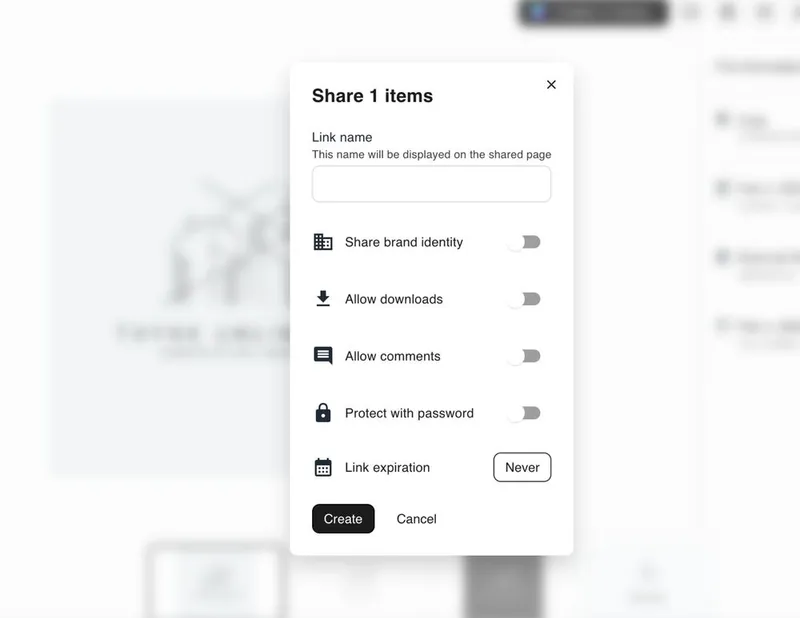
Once approved, assets need to be published across channels, such as websites, social platforms, ads, sales materials, etc. A digital asset management system enables controlled sharing, download presets, and integrations with CMSs and design tools.
Archiving & expiry: digital asset lifecycle management
Every asset has a shelf life. Digital asset management workflows include expiration dates, archiving rules, and usage rights tracking to prevent compliance risks and reduce clutter.
BrandLife supports rule-based archiving and rights management so assets are automatically retired when they’re no longer relevant.
Digital Asset Management Workflows: End-to-End Mapping
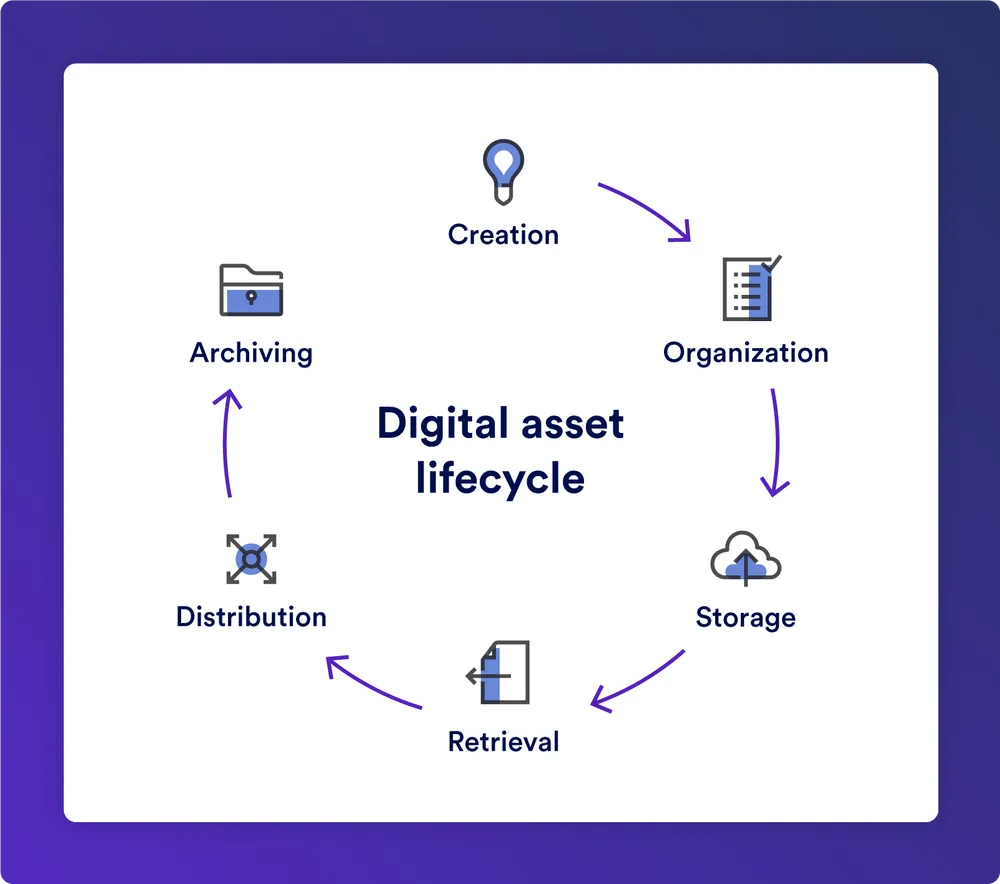
A typical digital asset management workflow follows a structured, repeatable path, ensuring assets are properly handled at every stage of their lifecycle. While details may vary depending on your team’s size, content volume, or campaign goals, most workflows include the following core steps:
- Content ingestion: Creative teams or external partners upload new assets into the digital asset management system.
- Asset organization: Assets are categorized using metadata fields, such as campaign, usage rights, region, or product line, for easy discoverability.
- Review and approval: Stakeholders provide feedback, suggest edits, or approve assets for use. A good brand asset management tool like BrandLife streamlines this step with built-in version control and comments.
- Distribution: Once approved, assets are published, downloaded, or distributed across channels, such as web, social, email, or internal portals.
- Archiving or expiry: Assets that are no longer relevant are either archived for future reference or automatically expire based on usage rights or internal policies.
5 Benefits of Digital Asset Management Workflows
A structured digital asset management workflow isn’t just about efficiency—it delivers measurable benefits across every stage of content creation and distribution.
Below, we explore the key advantages of implementing a well-defined digital asset management workflow.
1. Improve asset organization
With centralized storage and consistent metadata, assets are easy to tag, locate, and manage. Teams can quickly search, retrieve, and repurpose content without digging through folders.
2. Promote cross-team collaboration
Creative, marketing, legal, and external partners work together in a shared workspace. Real-time feedback loops and role-based workflows keep everyone aligned and moving forward.
3. Boost content productivity and turnaround
Streamlined approval processes reduce back-and-forth and minimize delays. This allows teams to move from creation to launch faster, keeping up with campaign timelines.
4. Maintain brand consistency across regions
Built-in version control and permissions ensure only approved assets are used. This safeguards brand integrity across teams, markets, and distribution channels.
5. Increase digital asset security
Role-based access, watermarking, and audit trails reduce risk and ensure compliance. Teams can control who sees what while tracking usage across the asset lifecycle.
5 Tips for Improving Your Digital Asset Management Workflow
Refining your digital asset management workflow doesn’t require a full overhaul. These practical tips can help you boost efficiency, collaboration, and brand control step by step.
1. Create a detailed asset classification system

When assets are properly labeled and categorized, your entire team can search, retrieve, and repurpose them with ease.
Actionable tips:
- Define a taxonomy that matches your business: Think in terms of campaigns, products, content type, region, language, and usage rights.
- Use consistent naming conventions (e.g., Q3-2025_EmailBanner_US_Promo1_v2.jpg) to make assets easy to scan and sort.
- Document these tagging rules and share them with every uploader to maintain consistency.
BrandLife supports custom metadata fields and preset tagging templates so that teams stay aligned from the start.
2. Implement version control
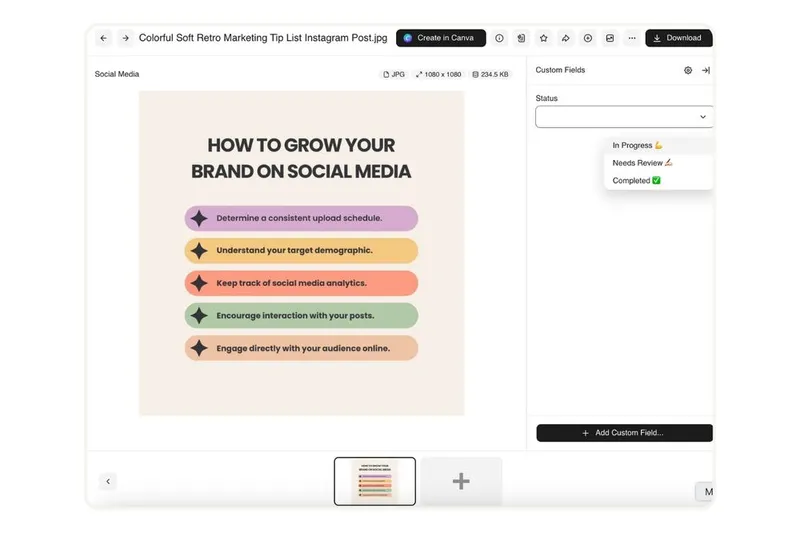
Multiple versions of the same file can create confusion, slow down approvals, and lead to brand inconsistency if outdated assets are used.
Actionable tips:
- Establish a single source of truth: All final versions should live in your digital asset management platform, not in local folders or inboxes.
- Use automated versioning: Let the DAM track version history and flag outdated files to prevent accidental use.
- Label drafts clearly (e.g., v1_draft, v3_final, v4_legal-edits) to help stakeholders identify the correct version.
- Lock or archive old versions once a new one is approved to avoid clutter.
BrandLife’s built-in version control automatically tracks edits and lets you compare file histories without manual file management.
3. Automate repetitive tasks
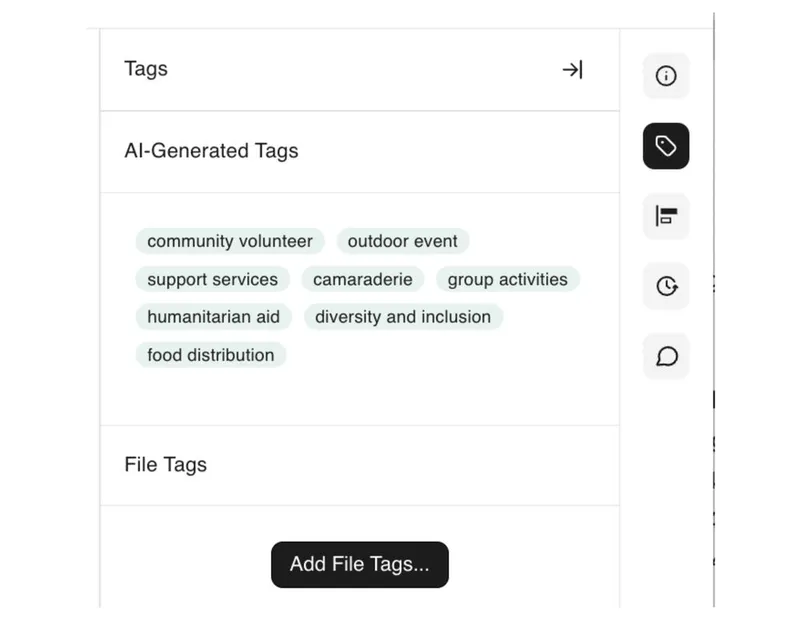
Manual processes like reformatting files or sending approval requests can eat up valuable time and slow down your content pipeline.
Actionable tips:
- Set up auto-tagging rules based on file properties (e.g., all uploaded images with “.png” get tagged as “web assets”).
- Automate file conversions—e.g., have high-res design files automatically generate web-friendly JPEG or social-friendly MP4 versions.
- Create workflow triggers: When an asset is uploaded and tagged “Q4 social,” route it to the social media manager for review.
- Use expiration dates to automate asset retirement and reduce compliance risks.
BrandLife enables custom automation triggers for tagging, file routing, and version approvals, making handoffs smoother and faster.
4. Enable collaboration features and tools
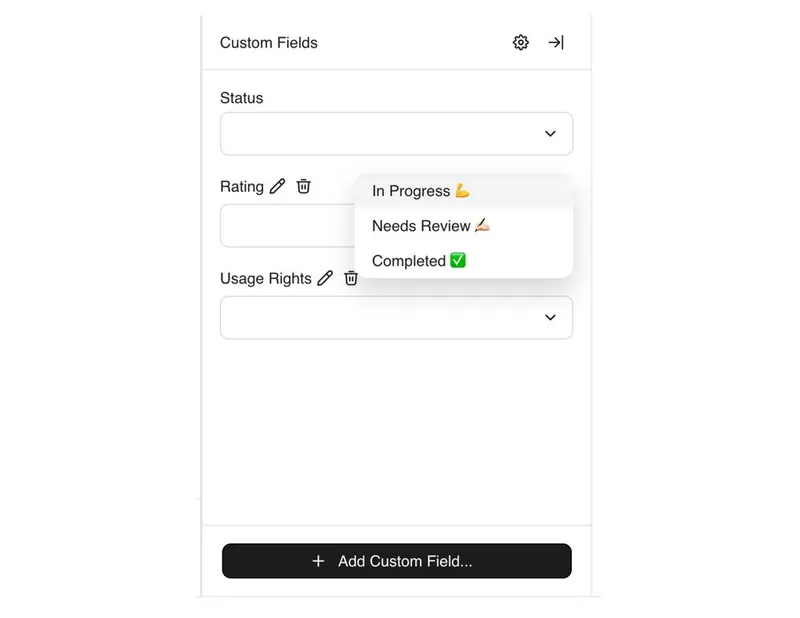
BrandLife’s workflow approval process
Review and approval are often the biggest bottlenecks in content production. With the right tools, you can speed up decision-making without sacrificing quality.
Actionable tips:
- Use in-line commenting and markup tools so reviewers can leave direct feedback on the asset itself.
- Assign roles (e.g., reviewer, approver, legal) and notify stakeholders when action is needed to avoid backlogs.
- Track approvals in one place—ditch scattered email threads.
- Use visual dashboards to track asset status: “in progress,” “awaiting approval,” “approved,” “archived.”
BrandLife offers real-time commenting, approval routing, and user roles—so everyone knows what’s next and nothing gets stuck in limbo.
5. Integrate with other tools

Even the best digital asset management system falls short if it's not connected to the tools your team uses daily.
Actionable tips:
- Sync your system with your CMS so approved images, videos, and PDFs can be published directly to your website.
- Connect to Adobe Creative Cloud, Canva, or Figma to enable designers to pull brand assets directly into their workspace.
- Integrate with project management tools like Asana, Trello, or Monday.com to track workflows in tandem with campaigns.
- Connect analytics or reporting tools to monitor which assets perform best, and optimize accordingly.
BrandLife integrates with a wide ecosystem of creative, publishing, and productivity platforms, helping you build an end-to-end content engine.
What Do You Need to Implement a Digital Asset Management Workflow?
To build an effective digital asset management workflow, you need more than just software—you need structure, alignment, and the right systems in place.
- Clear Processes and Workflow Mapping: Define who does what and when.
- A Scalable DAM Platform: Choose digital asset management workflow systems that support automation, tagging, and integrations.
- Team Alignment on Usage and Permissions: Standardize rules across departments.
- Governance Policies: Document protocols for asset creation, approval, and distribution.
Streamline Digital Asset Management Creative Workflows With BrandLife
BrandLife is built to simplify and scale your digital asset management creative workflow.
Whether you're managing global campaigns, launching new products, or rolling out a rebrand, BrandLife helps you move faster, stay consistent, and get the most out of every asset.
Here's how BrandLife helps you with an effective digital asset management workflow:
Centralized, searchable asset library
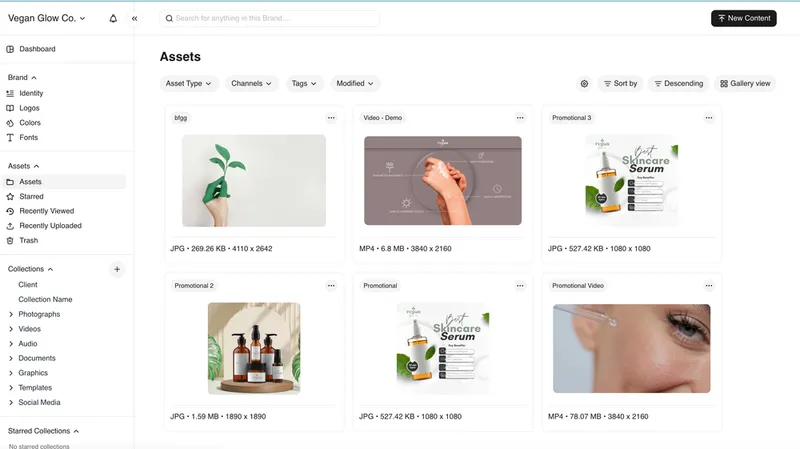
BrandLife provides a unified space for storing and organizing assets with robust metadata and tagging features, making it easy for teams to find exactly what they need, fast.
Built-in collaboration & approval tools

Teams can leave in-line feedback, track version history, and manage approvals without switching platforms, keeping reviews streamlined and transparent.
Customizable brand portals for easy access

BrandLife offers branded, self-serve portals where internal teams or external partners can access approved assets, guidelines, and templates—ensuring consistency without constant back-and-forth.
Ready to upgrade your digital asset management workflow? Start your 14-day free trial with BrandLife today.
Frequently Asked Questions
An asset management workflow outlines the step-by-step process for how digital assets are created, tagged, reviewed, approved, distributed, and archived. It ensures consistency, reduces bottlenecks, and helps teams scale content production efficiently.
Digital asset management workflows centralize asset access and streamline approvals, making it easier for cross-functional teams to review, comment, and stay aligned. Features like version control and real-time notifications reduce confusion and keep everyone on the same page.
You’ll need a robust digital asset management platform like BrandLife that supports automation, metadata tagging, approval workflows, permissions, and integrations with your existing creative and marketing tools. These features help teams manage assets efficiently and maintain brand control.





